History of book folding
Folding books is not an Asian or Japanese art of folding. The different types of folding to fold lettering and graphics into the visible edges of a book were invented by Anja Schachtner (Ingolstadt) and Dominik Meißner (Merzig).
The following is a list and short description of all publications that deal exclusively with the folding of magazine or book.
In addition, all publications that have published something for the first time that relates to follding magazine or book page. No e-books or websites are included in the listing.
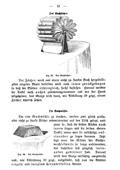
Because magazines have a different format than books, the objects cannot all be folded with a book. All the objects described can only be seen when they are additionally decorated.
In the same year, "SPRING PROJECTS Made of FOLDED MAGAZINES" by Aleene Jackson was published. Other magazines published by Aleene Jackson in 1966, 1967, 1972 were
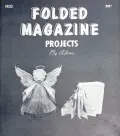
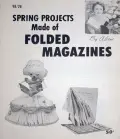
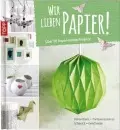

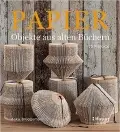

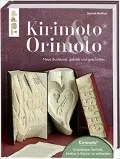
In addition, all publications that have published something for the first time that relates to follding magazine or book page. No e-books or websites are included in the listing.
-1890
If you have information about publications before 1891, please feel free to send us this information by eMail (info@orimoto.eu).
1891
The first known publication on book folding is Ida Bloch‘s "Illustriertes Spielbuch für Kinder", which was published in 1891. The book has 122 pages and two book objects: a book fan and a book mill. The book fan is the only one that is folded.
1892-1963
If you have information on publications that fall within the period between 1892 and 1963, please feel free to send us this information by eMail (info@orimoto.eu).
1964-1972
The first known publication that only involves folding books into three-dimensional objects, is the magazine "FOLDED MAGAZINES PROJECT" by Aleene Jackson, published in 1964. This 11 page magazine describes how magazines can be folded into a 3D object. There are 14 different objects included.Because magazines have a different format than books, the objects cannot all be folded with a book. All the objects described can only be seen when they are additionally decorated.
In the same year, "SPRING PROJECTS Made of FOLDED MAGAZINES" by Aleene Jackson was published. Other magazines published by Aleene Jackson in 1966, 1967, 1972 were
- "Projects Made of FOLDED MAGAZINES"
- "FOLDED MAGAZINE NOVELTIES" and
- "More FOLDED MAGAZINE PROJECTS".


1973-2013
If you have information on publications that fall within the period between 1973 and 2013, please feel free to send us this information by eMail (info@orimoto.eu).
März 2014
The first known publication about folding lettering and symbols (heart) into the front visible edge of a book, is the book "Wie Lieben Papier" published in March 2014. Dominik Meißner describes by using graphic pattern how lettering and symbols can be folded into books, by using the folding method- 45° folding only

August 2014
Reader’s Digest Association is publishing six folding books under the „Artfolds®“ trademark in August 2014. These books are provided with markings so that they can be folded directly. With these first folding books, the lettering "Love" and "Joy" as well as the symbols "Snowflake“, „Mickey Mouse“, „Heart“ und „Chrismas Tree“ can be folded. More folding books followed in March and September 2015.
September 2015
In September 2015, the book Papier-Objekte aus alten Büchern by Anka Brüggemann was published. In the 168-page book, are described in the 4 chapters as lettering on graph paper are recorded. From the graph paper, the lettering is measured and the values entered into a table. The values in the table are then transferred to the book pages. Since the lettering on the graph paper represents a graphic pattern, it is a transfer of the graphic pattern to the measurement pattern. Since Mrs. Anka Brüggemann describes the measuring method in detail and the book has other very interesting book objects, it is a must for every book lover and highly recommended.
Januar 2016
„Orimoto Faltkunst für Bücherfreunde“ is the first book dedicated exclusively to the folding of books. In this 144-page book, Dominik Meißner describes for the first time both methods (measuring and graphic method). In this book for the first time the folding methods- 45° cutting and folding,
- 180° folding,
- folding of the upper book block edge and
- Lazy folding

März 2018
„Kirimoto® & Orimoto®: Neue Buchkunst, gefaltet und geschnitten“ is the second book dedicated exclusively to the folding of books. In this 144-page book, Dominik Meißner presents for the first time the- oblique folding,
- 90° folding,
- 180° with different depths,
- 180° with folding over,
- 180° with double folding
- 180° inside reverce folding
- 180° lying books and
- 45° and 180° combination folding

The following is a listing and short description of all the methods and their history for folding lettering and graphics into the visible edges of a book.
The first official Orimoto® Program available over the internet was still quite small with 600 program lines and four files.
The basic difference between the English measuring method and the measuring method in the Orimoto® program is that in the English measuring method individual letters are folded into words in a book. That is, a fixed number of book leaves are required per character. If the leaves of the book are not enough it is cut up and a second one is glued on or, conversely, excess leaves are separated out. In the Orimoto® measurement method, which is derived from the Orimoto® graphic method, the desired word is adjusted to the specific book or book leaf number. Another difference is that the English measurement pattern has a numbering by book sheet (1, 2, 3, 4, ...) and the Orimoto® measurement pattern has a numbering by pagination (1, 3, 5, 7, ...). See also "180° folding" below.


Since Mrs. Anja Schachtner at that time folded and decorated all book objects for the book "Orimoto Faltkunst für Bücherfreunde" by order, this folding style was still included in the book at short notice. In the Orimoto® program, the template was already included as a graphic method, but was newly included as a measuring method as well.
The first Kirimoto book published only with the "180° cutting" folding method, "B", by Anja Schachtner was so well received on the social network at the end of August 2015 that this folding method was copied out of the Orimoto® program by other folders and competitor programs.
The "180° cutting" was also used to produce books with different cutting depths.




All three book block edges can be used for the folding type "180° cut". The first "3 page book" was presented by Mrs. Anja Schachtner.
In 2014, books were also folded using the top and front book block edges, but this required two pattern. (Photo www.lichtpunkt.cc)




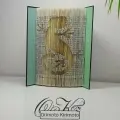
A simple method was presented by Dominik Meißner in February 2021. The patterns from the Orimoto programme are cut into strips, folded in the middle and glued to the front edge of the book leaf. This is not a new folding method, as the book is not folded or cut, but only the pattern from the Orimoto programme.
In February 2022, the Orimoto program was changed to the extent that the width of the strips on the pattern can be increased. The strips no longer need to be glued, they are inserted into the pre-folded book.
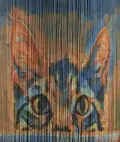
The finished book shows two different images depending on the direction you look at it. It comes into its own best when walking past the book. The pattern from the Orimoto program are used and processed just like the pattern strip version of February 2021. This is also no new folding type since here not the book is folded or cut but only the pattern from the Orimoto program.

1999
After several attempts to draw directly on the book block, Dominik Meißner started drawing the objects on graph paper and then transferring them to the book. Both are very inaccurate so he created the first graphic pattern using a simple graphics program.2001
As a computer scientist, it was obvious for him to have the graphic pattern created via a computer program. So the first Orimoto® program version was created in 2001. This version had only two input fields.- Last page number and
- Graphic file
2002-2012
Further improvements of the first Orimoto® Program version followed.The first official Orimoto® Program available over the internet was still quite small with 600 program lines and four files.
2013
The enhanced Orimoto® program version was released to the public in 2013 with regard of the book "Wir Lieben Papier".2014
After several requests, the measurement method was included in the Orimoto program in 2014. It probably comes from the English-speaking countries, since it was only used there at that time. Since the measuring method outputs the interruptions of an object on a book page with position/values in a table, the interrupted graphic method was included in the Orimoto® program at the same time.The basic difference between the English measuring method and the measuring method in the Orimoto® program is that in the English measuring method individual letters are folded into words in a book. That is, a fixed number of book leaves are required per character. If the leaves of the book are not enough it is cut up and a second one is glued on or, conversely, excess leaves are separated out. In the Orimoto® measurement method, which is derived from the Orimoto® graphic method, the desired word is adjusted to the specific book or book leaf number. Another difference is that the English measurement pattern has a numbering by book sheet (1, 2, 3, 4, ...) and the Orimoto® measurement pattern has a numbering by pagination (1, 3, 5, 7, ...). See also "180° folding" below.
2015
Until 2015, there was only the folding type "45° only fold (MMF)". Each book leaf was provided with one or two dog-ears. Per book leaf here is always only one interruption visible and foldable. It was not yet cut in the strict sense. The complete book block has already been cut in the middle so that two lines can be folded, but this cutting is like folding two small books that are then stacked on top of each other. This cutting creates a visible cut edge that is often concealed by a ribbon or other decorative objects.January 2015
On Jan. 28, 2015, the first "Lazy Folding" was published by Mrs. Anja Schachtner. In this folding method, only every second page of the book is folded. The name "lazy" came out of fun, it was actually about making a gift quickly. In German it is called "Faule Faltung".
July 2015
In order to fold several interruptions on a book page, the folding type "45° cutting (MMCF)" was developed by Dominik Meißner. With this type of folding, a central cut is made between two interruptions. Thus, several dog-ears are possible on one book page. The Orimoto® program was expanded at the same time to include this type of folding.
August 2015
Two weeks after posting the fold type "45° cutting" in the Orimoto® program, Mrs. Anja Schachtner did not cut in the middle between the interruptions but the interruptions themselves and folded them 180° around. This is how the folding type "180° cutting" was created. Here in the paw the M still in combination with the classic Orimoto® folding 45 degrees without cutting.Since Mrs. Anja Schachtner at that time folded and decorated all book objects for the book "Orimoto Faltkunst für Bücherfreunde" by order, this folding style was still included in the book at short notice. In the Orimoto® program, the template was already included as a graphic method, but was newly included as a measuring method as well.
The first Kirimoto book published only with the "180° cutting" folding method, "B", by Anja Schachtner was so well received on the social network at the end of August 2015 that this folding method was copied out of the Orimoto® program by other folders and competitor programs.
The "180° cutting" was also used to produce books with different cutting depths.



December 2015
The folding type "90° cutting" was published in the Orimoto® program. The idea for it exists since August 2015 but the programming implementation and the description for it took some more time. (Photo and folding by P. Schröder)
February 2016
The fold type "180° one-sided cut" was already included in the Orimoto program in December 2015, but only now activated and presented. In the course of this, a further 21 folding types were introduced, which can be derived from the existing ones.All three book block edges can be used for the folding type "180° cut". The first "3 page book" was presented by Mrs. Anja Schachtner.
In 2014, books were also folded using the top and front book block edges, but this required two pattern. (Photo www.lichtpunkt.cc)


August 2017
The first folding type with an "oblique fold" was published by Dominik Meißner on the social network at the end of August 2017. This was then quickly followed by the "double oblique fold" by Mrs. Anja Schachtner at the beginning of September 2017.

September 2017
Double folding to create two book page edges from one book page edge was invented by Dominik Meißner. On the one hand, this allows double the number of book leaf edges (pages) to be created from thin books with few pages, and on the other hand, it creates a different look (photo and folding by Anja Schachtner). The simple folding is the 180° fold.
February 2021
The Orimoto patterns were used to transfer the colours of the graphics onto the edges of the book sheets with coloured pencil. This method of painting on the edge of the book block is called (Fore-edge Painting) and the oldest known printed work using a book-edge painting is from 1649.A simple method was presented by Dominik Meißner in February 2021. The patterns from the Orimoto programme are cut into strips, folded in the middle and glued to the front edge of the book leaf. This is not a new folding method, as the book is not folded or cut, but only the pattern from the Orimoto programme.
In February 2022, the Orimoto program was changed to the extent that the width of the strips on the pattern can be increased. The strips no longer need to be glued, they are inserted into the pre-folded book.

March 2022
In the style of the glued strips presented in February 2021, the two-sides book was created. This type is also called multi-image pictures or lenticular lens. The production of multi-image pictures with wooden slats was first described in 1636 by M. Danielem Schwenterum from Nuremberg in the book "Deliciæ physico-mathematicæ" . From paper strips, a three-page image was first mentioned in 1661 by Thomas Powell of London in the book "Humane Industry" .The finished book shows two different images depending on the direction you look at it. It comes into its own best when walking past the book. The pattern from the Orimoto program are used and processed just like the pattern strip version of February 2021. This is also no new folding type since here not the book is folded or cut but only the pattern from the Orimoto program.

Orimoto® pattern program
The Orimoto® program exists officially around 23 years.
No installation is necessary because this is the Orimoto® program and it is already running on your internet enabled device.
The full version for individuals can be purchased via an account in the free version. If you need a company licence for e.g. a library, a rehabilitation centre, a school, etc., please send an eMail with your request to info@orimoto.eu.
In the free version, the button can be used to open the full version for viewing. In the full version, the number of pages and the height of the book are also different from those in the free version
The full version can create patterns of the following folding types:
No installation is necessary because this is the Orimoto® program and it is already running on your internet enabled device.
Free version
The free version of the Orimoto® program is free of charge so you can test the Orimoto® program first and see if you enjoy folding books. You may sell and display your folded books but not with the name Orimoto® or Kirimoto®, these are wordmarks. You may not sell or give away the patterns created by the Orimoto® program!Full version
The full version is chargeable and it is available in three variants:- with a maximum of 2 patterns,
- with a maximum of 15 patterns and
- with unlimited patterns.
The full version for individuals can be purchased via an account in the free version. If you need a company licence for e.g. a library, a rehabilitation centre, a school, etc., please send an eMail with your request to info@orimoto.eu.
In the free version, the button can be used to open the full version for viewing. In the full version, the number of pages and the height of the book are also different from those in the free version
- Number of pages from 50 to 4,000
- Book height from 5 cm to 84.1 cm
- Lettering from 1 to 999 characters
The full version can create patterns of the following folding types:
- 45° folding only (MMF)
- 45° cut and fold
- 90°
- 180° (C&F)
- Shadow folding
- Lazy fold
- Oblique folding
- Combination
- Fore-edge strips
The full version can create patterns for all 42 different folding types.
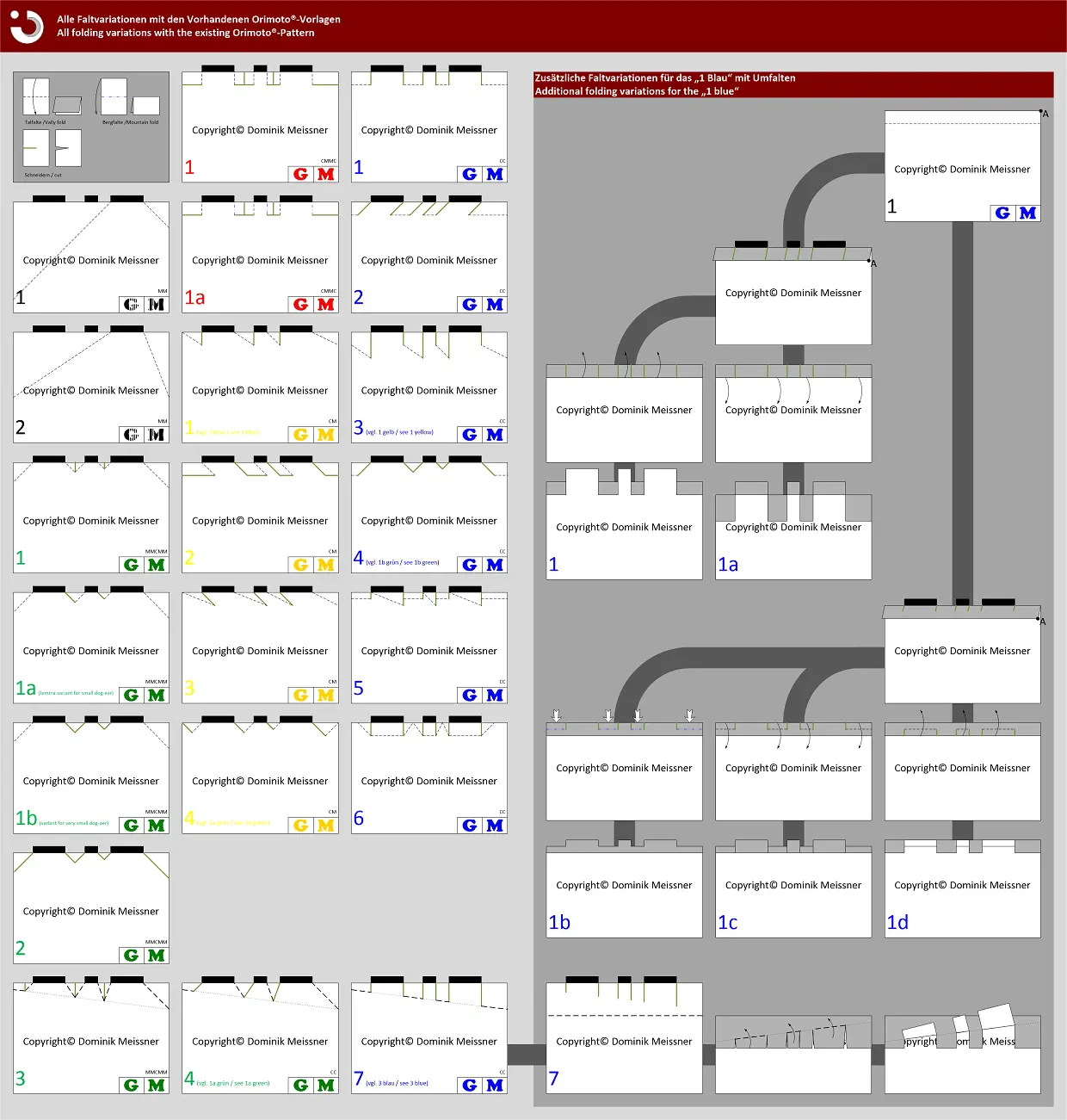

Since May. 2019, the book preview in the Orimoto® program shows you how the folded book might look (WYSIWYG).
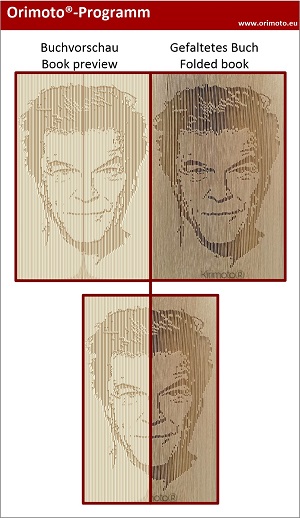

As of March 2020, the Orimoto® program can interpret coloured graphics and displays the colours differently.
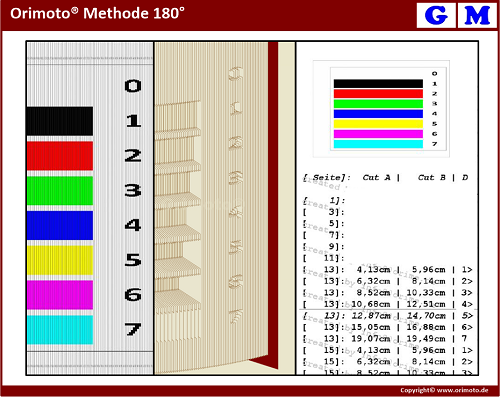

As of February 2021, the Orimoto program has been modified to allow the width of the strips on the pattern to be increased. This makes the Fore-edge strips book easier to work with.
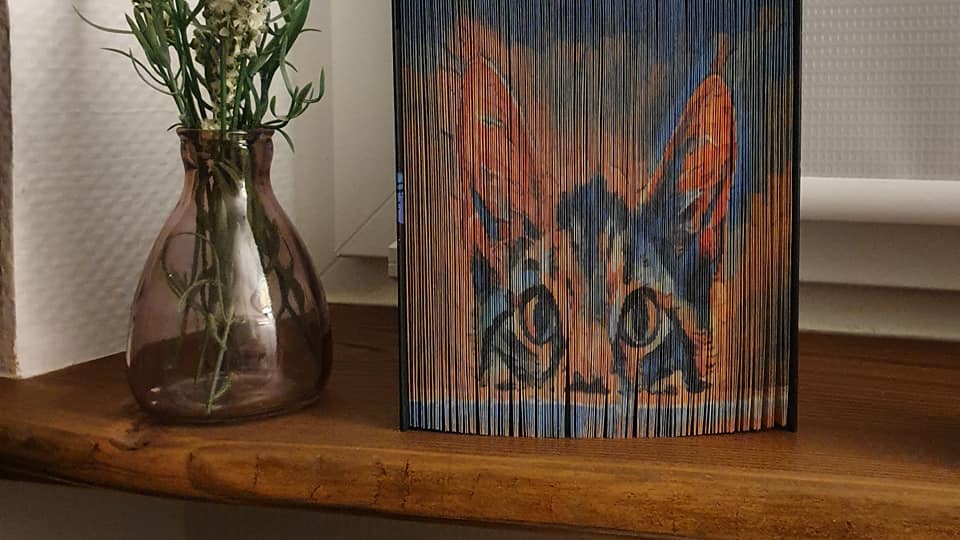

Privacy:
If you do not log in to the free version of the Orimoto® program for 6 months, your account and all your data will be automatically deleted from the Orimoto® program. You can create a new account again at any time.Pattern:
The program has created 3,418,639 personalized patterns so far to fold 1,564,854,346 pages. To create a personalized pattern, the program needs 5-10 seconds.
The only place to get personalized patterns for free (as many as you like).
Yes, you may sell your folded books, but you must not sell or share the patterns created by the program!
The only place to get personalized patterns for free (as many as you like).
Yes, you may sell your folded books, but you must not sell or share the patterns created by the program!


















































Excel Vorlagen
Wie Sie mit Excel Vorlagen selber machen wird auf dieser Seite erklärt.
In diesem Anleitungsbuch ist zudem grob erklärt, wie sie sich mit einem Tabellenkalkulations Programm, z.B. Microsoft Excel, LibreOffice, OpenOffice Calc, etc. Vorlagen selber machen können.




















































"Konkurrenz" Programme
Da das Orimoto Programm 2002 das erste Programm war, mit dem Vorlagen zum Bücherfalten erstellt werden konnte, sind die nachfolgenden aufgelisteten Programm keine Konkurrenz Programm, sondern nur Kopien.
- bookami® Programm
- Book Art Design Software (BADS)
- foldsy® Programm
- crafty49 Programm
- lotus book folding
- vektorrascheln Programm
- Wunderfold


















































Information
Wenn Sie soweit runter geblättert haben wissen Sie warum, diese Information hier steht ;-)
- bookami® Programm
- Book Art Design Software
- foldsy® Programm
- crafty49 Programm
- lotus book folding
- vektorrascheln Programm
- Wunderfold


















































Orimoto® pattern program
The Orimoto® program exists officially around 23 years.
No installation is necessary because this is the Orimoto® program and it is already running on your internet enabled device.
The full version for individuals can be purchased via an account in the free version. If you need a company licence for e.g. a library, a rehabilitation centre, a school, etc., please send an eMail with your request to info@orimoto.eu.
In the free version, the button can be used to open the full version for viewing. In the full version, the number of pages and the height of the book are also different from those in the free version
The full version can create patterns of the following folding types:
No installation is necessary because this is the Orimoto® program and it is already running on your internet enabled device.
Free version
The free version of the Orimoto® program is free of charge so you can test the Orimoto® program first and see if you enjoy folding books. You may sell and display your folded books but not with the name Orimoto® or Kirimoto®, these are wordmarks. You may not sell or give away the patterns created by the Orimoto® program!Full version
The full version is chargeable and it is available in three variants:- with a maximum of 2 patterns,
- with a maximum of 15 patterns and
- with unlimited patterns.
The full version for individuals can be purchased via an account in the free version. If you need a company licence for e.g. a library, a rehabilitation centre, a school, etc., please send an eMail with your request to info@orimoto.eu.
In the free version, the button can be used to open the full version for viewing. In the full version, the number of pages and the height of the book are also different from those in the free version
- Number of pages from 50 to 4,000
- Book height from 5 cm to 84.1 cm
- Lettering from 1 to 999 characters
The full version can create patterns of the following folding types:
- 45° folding only (MMF)
- 45° cut and fold
- 90°
- 180° (C&F)
- Shadow folding
- Lazy fold
- Oblique folding
- Combination
- Fore-edge strips
The full version can create patterns for all 42 different folding types.


Since May. 2019, the book preview in the Orimoto® program shows you how the folded book might look (WYSIWYG).


As of March 2020, the Orimoto® program can interpret coloured graphics and displays the colours differently.


As of February 2021, the Orimoto program has been modified to allow the width of the strips on the pattern to be increased. This makes the Fore-edge strips book easier to work with.

